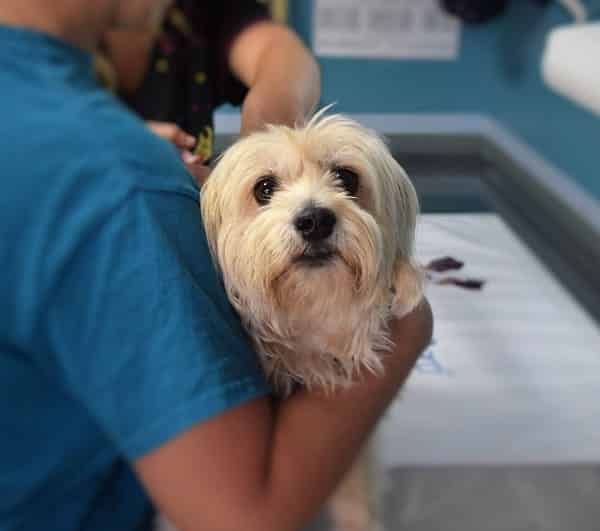How To Treat A Dog Stye At Home Very Easily

If your lovely pet dog is having a stye eye, then I guess you need a quick remedy to treat her and get rid of the stye eye immediately.
The good news is that treating a dog’s stye eye is usually not complicated and you can easily do it by yourself at home.
This article contains a simple step-by-step guide that will show you how you can treat your dog’s stye eyes.
But in case you don’t want to treat your dog by yourself, then it’s okay to learn about the dog stye eye, what it is, its symptoms, and prevention techniques.
Also, you may need to consult with a veterinarian for proper medication for your dog.
So, without much ado let’s get into details about how to treat a dog stye eye.

How to Treat a Dog Stye
Treating styes in dogs is really not that complicated as we know it sometimes heals on its own. As a result, it can be done at home.
However, when the stye looks acute due to other issues it requires some medication. In most cases, a veterinarian will have to remove the stye physically.
Here are some things you can do to treat your dog’s stye eye.
1. Good Hygiene:
The initial treatment of a dog’s stye is to keep the area clean by washing the surroundings of the eyelid.
Doing this helps remove whatever is causing the bump and clears the bacteria.
A plain clean cloth dipped in warm water will work just fine for the task.
2. Compresses:
Once the eye is clean, applying a compress with a warm cloth to the dog’s style eyes 3 to 5 times a day for about 10 to 15 minutes can help speed recovery.
Although, this depends on how receptive the dog is to the process. As such, this calls for you to be very gentle in applying a compress.
3. Medication:
As bacteria is the cause of the infection, medicated eyewashes and ointments can help with the process.
These types of medications are usually easy to apply because all you need to do is gently pull up the dog’s head and then apply the ointment on the eyelid.
However, a veterinarian might administer oral antibiotics instead as they are easy to disguise in food.
Precautions to follow while treating your dog’s stye eye:
- Always wash your hands before and after applying the treatment to your dog.
- You must always use clean and disinfected clothes.
- If your dog doesn’t cooperate during the process of home treatment, it’s advisable to stop and visit a veterinarian.
As much as treatments are good, you should also consider preventive measures to avoid your dog getting a stye.
Related: How to Treat a Limping Dog at Home (12 Natural Remedies)
What is Dog Stye?
A Dog eye stye is a condition that happens in or around a dog’s eye and causes irritation and pain.
It normally appears like a red bump or a pimple on the dog’s eyelid. However, this type of stye is called a hordeolum.
Although the swelling is usually temporary, at times they grow quite large and this is a result of the bacteria behind it known as staphylococcus aureus.
This is usually not a serious condition as it can happen to any breed, sex, or age of a dog. However, dogs with low immune systems may have more serious conditions than others.
Sometimes, if the stye causes the dog to scratch their eyes, it can lead to bigger conditions.
When dog scratches their eyes, they can cause physical damage to their eyes with their claws.
In addition, this can lead to extreme cases where they develop corneal ulcers. However, the symptoms in most dogs are inflammation, which is accompanied by redness, swelling as well and tearing in the dog’s eyes.
Let’s find out other things that cause swelling in a dog’s eyelid.
You may also like to read this trending guide: Emotional Support Animals (Everything You Need to Know)
What are Other Causes of Swelling on a Dog’s eyelid?
A dog’s stye is not necessarily the only thing that can cause inflammation in a dog’s eyelid.
In cases where the swelling refuses to go down, it is advised to visit a veterinarian in order to check out other conditions that could be mistaken for stye.
Below are examples of diseases that have similar symptoms to stye in dogs;
1. Entropion:
This is a condition whereby the eyelid turns inward thereby causing the eyelashes to rub against the eye surface.
Although, it can be due to the shape of their eyelid and this is common in some breeds like BullDog and Shar-Pei.
Some related symptoms are redness, excessive tearing, and rubbing at the eyes.
2. Conjunctivitis and Ulcers:
These conditions in dogs can lead to excessive tearing and pain as they affect the eyes of the dog by causing redness of the eyelid.
Conjunctivitis in dogs is an irritation due to inflammation of the conjunctiva which is a tissue on the eyelid.
3. Tumors:
Skin tumors in dogs sometimes appear in the eyelid area.
As a result, they appear as bumps which are often mistaken as stye but they are harder than stye.
4. Third Eyelid:
Dogs have a third eyelid which is also known as the nictitating membrane.
The nictitans gland is one of the glands that produce the tear film which keeps the surface of the eyes wet but when it can’t, it leads to prolapse.
Thereby producing a bump near the inner corner of the dog’s eye.
Let’s find out symptoms to check out for in determining if your dog has a stye eye..
How can I tell my dog has a stye?
Styes are usually not hard to spot as they normally form at the corner of the dog’s eyelid.
Here are some symptoms to look out for:
- Finding your dog always rubbing their eyes.
- Swelling of the eyes.
- Inflammation on the inside or outside of the eyes.
- Redness in the eyes.
- Fluid discharge from the eyes for example pus.
It’s important to note that your veterinarian is in the best position to determine if your dog has a style or not.
So, when you see symptoms like this it’s best you book an appointment with your veterinarian.

Related: How to Treat Dog Paw Pad Cuts at Home
Ways to Prevent your Dog from having Stye
As you know, prevention is better than cure.
For you to prevent your dog from getting dog stye, follow these instructions;
- Always clean your dog’s face properly while bathing them.
- Use protective classes to cover your dog’s eyes.
- Stop them from rubbing their eyes regularly either by training or just distracting them.
- When outside with your dog, always use clean cotton wipes to clean your dog’s eyes regularly.
- During windy days close your house windows and also while taking them on a drive.
- If your dog refuses to stop rubbing its eyes, use a cone (also called an Elizabethan collar) for a few days to help restrict it from scratching.
Conclusion
Styes in dogs are usually not a thing to worry about except that they can be very painful and uncomfortable for a dog.
Some dogs are allergic to soap and shampoo, which might result in an eye infection.
Infections might spread due to poor treatment and an unsanitary environment.
Even though it’s not difficult to tell if your dog has a stye, we recommend visiting the vet just to be sure.
More dangerous illnesses, such as a tumor and ulcers, can sometimes mimic the symptoms of a stye.
A stye can, of course, go away on its own.
However, if the do stye does not go away after following the basic home remedies in this guide, then it’s best to consult your veterinarian for help.
Frequently Asked Questions
What is a dog stye?
A dog stye, also known as a canine stye or hordeolum, is a small, painful lump that can develop on or near a dog’s eyelid. It is typically caused by a blocked oil gland in the eyelid.
How can I tell if my dog has a stye?
You can tell if your dog has a stye if you notice a red, swollen bump on or near their eyelid. Dogs with styes may also blink or paw at their eye due to discomfort.
Can I treat my dog’s stye at home?
Mild cases of dog styes may resolve on their own, but it’s essential to consult with a veterinarian for proper diagnosis and treatment. They may recommend warm compresses and antibiotic ointments.
Is it safe to use human stye drops on my dog?
It’s not recommended to use human stye drops or medications on your dog without veterinary guidance. Consult your vet for dog-specific treatment options.
What can a veterinarian do to treat my dog’s stye?
A vet can assess the stye’s severity and may prescribe antibiotics, ointments, or, in rare cases, perform a minor surgical procedure to drain the stye.
How long does it take for a dog stye to heal?
The healing time for a dog stye can vary, but with proper treatment, it typically takes a week or two for the stye to resolve completely.
Are dog styes contagious to other pets or humans?
Dog styes are not typically contagious to humans or other pets. They are usually caused by a localized issue in the dog’s eye and do not spread easily to others. However, good hygiene practices are always recommended to prevent the spread of any potential infections.
References
- Pettable.com – How Do I Treat a Dog Stye
- Fastesaletters.com – Dog Stye: Causes and Treatment





